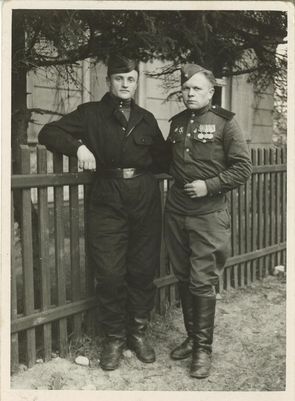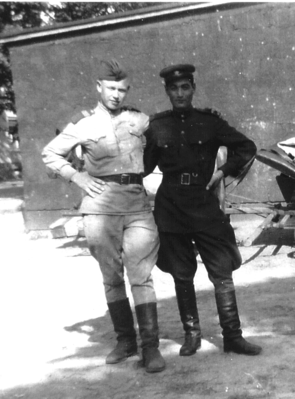Saturday, 19 May 1945
Kaulsdorf: Recruitment into the Red Army
Even after their liberation, many forced labourers of Soviet nationality (so-called "Eastern workers") have hardly any possibility to deal with the changed situation. As long as they are in good health and are not accused of collaborating with the enemy, the Red Army immediately obliges them to do their military service. Already during the advance on the Reich capital, the Soviet troops recruited liberated forced labourers into their own ranks. Some took part in the Battle of Berlin as Red Army soldiers. The former Ukrainian forced labourer Sigmund Iwanowitsch Sdorowezkij reports: "Immediately after the liberation at the beginning of April [sic!] I was drafted into the Soviet army and was deployed in the storming of Berlin. I was wounded and buried in the fighting for Berlin. The Soviet Army treated me like everybody else."
Piotr Emelyanovich Besrutschko remembers his liberation at the camp at Kaulsdorfer Strasse 90: "One night in April I woke up, and in the camp were our tanks, guns and Katyusha. All the guards had fled. In the morning our [soldiers] came into the barracks and said that we should pack up and line up outside. They sent us to Strausberg ... The next day we were bathed, we were given army uniforms and so we were already in the army."
Many liberated forced labourers see it as an honourable duty to serve in the Red Army. For example, Vasyl T. Kudrenko, who worked for a lieutenant in Berlin immediately after liberation: "This is how our life passes, far from home, in the cave of the beaten and defeated fascist beast that surrendered... I decided to give all my strength for the prosperity and the cause of my homeland, without sparing my own life."
However, even those who enthusiastically enter the military service are usually not exempt from political scrutiny by officers of the Soviet secret service. Thus Kudrenko noted in his diary on May 25, 1945: "Today it has become known to me that I have to go to the transit point by order of the head of department for the purpose of continuing my journey to the Soviet Union... Our Soviet security service is carefully controlling the flow of people, because several traitors ... have penetrated into Germany. The security forces are always right. I do understand. I am an innocent man. I was forcibly deported."
In most cases, immediate recruitment into the Red Army delays the return of former forced laborers to their homes by months or even years. The Ukrainian forced laborer Mikhail Ivanovich Kodash first had to work at GASAG in Berlin-Köpenick before 1945. He is then employed as a gofer at the DEMAG tank factory in Berlin-Spandau. After his liberation in the spring of 1945 in Nauen near Berlin, Kodasch is enlisted in the Red Army for four years: "I worked as a tractor driver. Nobody expected me at home." In 1949 he is discharged from military service in Halle (Saale).
Not only men, but also Soviet women are still being drafted by the Red Army on German soil and assigned to work in various departments. The Ukrainian N. S. Wladyschtschenko reports: "The majority of the male Eastern workers went to the fighting troops, and I worked with other girls in the army kitchen."
Marfa Semyonovna Bukhal from Dudarkov in Ukraine also remembers: "We were liberated by the Red Army on April 22, 1945. They sent us on foot on the same route as the ammunition to the front. In the Soviet Army, no one blamed us... we were treated like relatives."
(Sources: "Forced Labour in Berlin 1938-1945, ed. Arbeitskreis Berliner Regionalmuseen, Berlin: Metropol-Verlag 2003; "So it was. Forced Labour in the Dahme-Spreewald Region," published by Kulturlandschaft Dahme-Spreewald e.V., Zeuthen: 2011; letter from Mikhail Ivanovich Kodasch to the Berlin History Workshop, Nazi Forced Labour Documentation Centre; "Das Lagertagebuch des Zwangsarbeiters Wasyl T. Kudrenko," published by Wolfgang G. Krogel, Berlin: Wichern-Verlag 2005.

